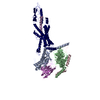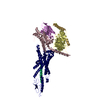+ データを開く
データを開く
- 基本情報
基本情報
| 登録情報 | データベース: PDB / ID: 6vcb | ||||||
|---|---|---|---|---|---|---|---|
| タイトル | Cryo-EM structure of the Glucagon-like peptide-1 receptor in complex with G protein, GLP-1 peptide and a positive allosteric modulator | ||||||
 要素 要素 |
| ||||||
 キーワード キーワード | SIGNALING PROTEIN/MEMBRANE PROTEIN / G protein-coupled receptor / membrane protein / family B GPCR / diabetes / allosteric modulator / SIGNALING PROTEIN-MEMBRANE PROTEIN complex | ||||||
| 機能・相同性 |  機能・相同性情報 機能・相同性情報glucagon receptor binding / glucagon-like peptide 1 receptor activity / glucagon receptor activity / hormone secretion / positive regulation of blood pressure / negative regulation of execution phase of apoptosis / post-translational protein targeting to membrane, translocation / feeding behavior / response to psychosocial stress / regulation of heart contraction ...glucagon receptor binding / glucagon-like peptide 1 receptor activity / glucagon receptor activity / hormone secretion / positive regulation of blood pressure / negative regulation of execution phase of apoptosis / post-translational protein targeting to membrane, translocation / feeding behavior / response to psychosocial stress / regulation of heart contraction / positive regulation of calcium ion import / cellular response to glucagon stimulus / positive regulation of insulin secretion involved in cellular response to glucose stimulus / peptide hormone binding / PKA activation in glucagon signalling / regulation of insulin secretion / hair follicle placode formation / developmental growth / D1 dopamine receptor binding / intracellular transport / Synthesis, secretion, and deacylation of Ghrelin / Hedgehog 'off' state / adenylate cyclase-activating adrenergic receptor signaling pathway / activation of adenylate cyclase activity / positive regulation of gluconeogenesis / protein kinase A signaling / adenylate cyclase activator activity / negative regulation of blood pressure / cAMP-mediated signaling / trans-Golgi network membrane / positive regulation of peptidyl-threonine phosphorylation / response to activity / gluconeogenesis / G-protein beta/gamma-subunit complex binding / bone development / Olfactory Signaling Pathway / Activation of the phototransduction cascade / adenylate cyclase-modulating G protein-coupled receptor signaling pathway / G beta:gamma signalling through PLC beta / Presynaptic function of Kainate receptors / Thromboxane signalling through TP receptor / adenylate cyclase-activating G protein-coupled receptor signaling pathway / G protein-coupled acetylcholine receptor signaling pathway / G-protein activation / hormone activity / Activation of G protein gated Potassium channels / Inhibition of voltage gated Ca2+ channels via Gbeta/gamma subunits / Prostacyclin signalling through prostacyclin receptor / transmembrane signaling receptor activity / Glucagon signaling in metabolic regulation / G beta:gamma signalling through CDC42 / cognition / platelet aggregation / ADP signalling through P2Y purinoceptor 12 / G beta:gamma signalling through BTK / Synthesis, secretion, and inactivation of Glucagon-like Peptide-1 (GLP-1) / Sensory perception of sweet, bitter, and umami (glutamate) taste / photoreceptor disc membrane / Adrenaline,noradrenaline inhibits insulin secretion / Glucagon-type ligand receptors / Vasopressin regulates renal water homeostasis via Aquaporins / G alpha (z) signalling events / cellular response to catecholamine stimulus / Glucagon-like Peptide-1 (GLP1) regulates insulin secretion / ADORA2B mediated anti-inflammatory cytokines production / sensory perception of taste / ADP signalling through P2Y purinoceptor 1 / adenylate cyclase-activating dopamine receptor signaling pathway / G beta:gamma signalling through PI3Kgamma / cellular response to prostaglandin E stimulus / Cooperation of PDCL (PhLP1) and TRiC/CCT in G-protein beta folding / GPER1 signaling / G-protein beta-subunit binding / Inactivation, recovery and regulation of the phototransduction cascade / heterotrimeric G-protein complex / positive regulation of peptidyl-serine phosphorylation / G alpha (12/13) signalling events / extracellular vesicle / glucose homeostasis / sensory perception of smell / signaling receptor complex adaptor activity / Thrombin signalling through proteinase activated receptors (PARs) / GTPase binding / retina development in camera-type eye / Ca2+ pathway / positive regulation of cold-induced thermogenesis / phospholipase C-activating G protein-coupled receptor signaling pathway / positive regulation of cytosolic calcium ion concentration / G alpha (i) signalling events / fibroblast proliferation / G alpha (s) signalling events / G alpha (q) signalling events / Ras protein signal transduction / secretory granule lumen / Extra-nuclear estrogen signaling / cell population proliferation / positive regulation of ERK1 and ERK2 cascade / learning or memory / cell surface receptor signaling pathway / G protein-coupled receptor signaling pathway 類似検索 - 分子機能 | ||||||
| 生物種 |  Homo sapiens (ヒト) Homo sapiens (ヒト) | ||||||
| 手法 | 電子顕微鏡法 / 単粒子再構成法 / クライオ電子顕微鏡法 / 解像度: 3.3 Å | ||||||
 データ登録者 データ登録者 | Sun, B. / Feng, D. / Bueno, A. / Kobilka, B. / Sloop, K. | ||||||
 引用 引用 |  ジャーナル: Nat Chem Biol / 年: 2020 ジャーナル: Nat Chem Biol / 年: 2020タイトル: Structural insights into probe-dependent positive allosterism of the GLP-1 receptor. 著者: Ana B Bueno / Bingfa Sun / Francis S Willard / Dan Feng / Joseph D Ho / David B Wainscott / Aaron D Showalter / Michal Vieth / Qi Chen / Cynthia Stutsman / Betty Chau / James Ficorilli / ...著者: Ana B Bueno / Bingfa Sun / Francis S Willard / Dan Feng / Joseph D Ho / David B Wainscott / Aaron D Showalter / Michal Vieth / Qi Chen / Cynthia Stutsman / Betty Chau / James Ficorilli / Francisco J Agejas / Graham R Cumming / Alma Jiménez / Isabel Rojo / Tong Sun Kobilka / Brian K Kobilka / Kyle W Sloop /   要旨: Drugs that promote the association of protein complexes are an emerging therapeutic strategy. We report discovery of a G protein-coupled receptor (GPCR) ligand that stabilizes an active state ...Drugs that promote the association of protein complexes are an emerging therapeutic strategy. We report discovery of a G protein-coupled receptor (GPCR) ligand that stabilizes an active state conformation by cooperatively binding both the receptor and orthosteric ligand, thereby acting as a 'molecular glue'. LSN3160440 is a positive allosteric modulator of the GLP-1R optimized to increase the affinity and efficacy of GLP-1(9-36), a proteolytic product of GLP-1(7-36). The compound enhances insulin secretion in a glucose-, ligand- and GLP-1R-dependent manner. Cryo-electron microscopy determined the structure of the GLP-1R bound to LSN3160440 in complex with GLP-1 and heterotrimeric G. The modulator binds high in the helical bundle at an interface between TM1 and TM2, allowing access to the peptide ligand. Pharmacological characterization showed strong probe dependence of LSN3160440 for GLP-1(9-36) versus oxyntomodulin that is driven by a single residue. Our findings expand protein-protein modulation drug discovery to uncompetitive, active state stabilizers for peptide hormone receptors. | ||||||
| 履歴 |
|
- 構造の表示
構造の表示
| ムービー |
 ムービービューア ムービービューア |
|---|---|
| 構造ビューア | 分子:  Molmil Molmil Jmol/JSmol Jmol/JSmol |
- ダウンロードとリンク
ダウンロードとリンク
- ダウンロード
ダウンロード
| PDBx/mmCIF形式 |  6vcb.cif.gz 6vcb.cif.gz | 225.1 KB | 表示 |  PDBx/mmCIF形式 PDBx/mmCIF形式 |
|---|---|---|---|---|
| PDB形式 |  pdb6vcb.ent.gz pdb6vcb.ent.gz | 172 KB | 表示 |  PDB形式 PDB形式 |
| PDBx/mmJSON形式 |  6vcb.json.gz 6vcb.json.gz | ツリー表示 |  PDBx/mmJSON形式 PDBx/mmJSON形式 | |
| その他 |  その他のダウンロード その他のダウンロード |
-検証レポート
| 文書・要旨 |  6vcb_validation.pdf.gz 6vcb_validation.pdf.gz | 918.1 KB | 表示 |  wwPDB検証レポート wwPDB検証レポート |
|---|---|---|---|---|
| 文書・詳細版 |  6vcb_full_validation.pdf.gz 6vcb_full_validation.pdf.gz | 927.4 KB | 表示 | |
| XML形式データ |  6vcb_validation.xml.gz 6vcb_validation.xml.gz | 36.4 KB | 表示 | |
| CIF形式データ |  6vcb_validation.cif.gz 6vcb_validation.cif.gz | 55.7 KB | 表示 | |
| アーカイブディレクトリ |  https://data.pdbj.org/pub/pdb/validation_reports/vc/6vcb https://data.pdbj.org/pub/pdb/validation_reports/vc/6vcb ftp://data.pdbj.org/pub/pdb/validation_reports/vc/6vcb ftp://data.pdbj.org/pub/pdb/validation_reports/vc/6vcb | HTTPS FTP |
-関連構造データ
- リンク
リンク
- 集合体
集合体
| 登録構造単位 | 
|
|---|---|
| 1 |
|
- 要素
要素
-Glucagon-like peptide ... , 2種, 2分子 RP
| #1: タンパク質 | 分子量: 51233.109 Da / 分子数: 1 / 由来タイプ: 合成 / 由来: (合成)  Homo sapiens (ヒト) / 参照: UniProt: P43220 Homo sapiens (ヒト) / 参照: UniProt: P43220 |
|---|---|
| #2: タンパク質・ペプチド | 分子量: 3359.699 Da / 分子数: 1 / 由来タイプ: 合成 / 由来: (合成)  Homo sapiens (ヒト) / 参照: UniProt: P01275 Homo sapiens (ヒト) / 参照: UniProt: P01275 |
-Guanine nucleotide-binding protein ... , 3種, 3分子 ABG
| #3: タンパク質 | 分子量: 44326.160 Da / 分子数: 1 / 由来タイプ: 組換発現 / 由来: (組換発現)  Homo sapiens (ヒト) / 遺伝子: GNAS, GNAS1, GSP Homo sapiens (ヒト) / 遺伝子: GNAS, GNAS1, GSP発現宿主:  参照: UniProt: P63092 |
|---|---|
| #4: タンパク質 | 分子量: 38534.062 Da / 分子数: 1 / 由来タイプ: 組換発現 / 由来: (組換発現)  Homo sapiens (ヒト) / 遺伝子: GNB1 Homo sapiens (ヒト) / 遺伝子: GNB1発現宿主:  参照: UniProt: P62873 |
| #5: タンパク質 | 分子量: 7861.143 Da / 分子数: 1 / 由来タイプ: 組換発現 / 由来: (組換発現)  Homo sapiens (ヒト) / 遺伝子: GNG2 Homo sapiens (ヒト) / 遺伝子: GNG2発現宿主:  参照: UniProt: P59768 |
-抗体 / 非ポリマー , 2種, 2分子 N

| #6: 抗体 | 分子量: 17352.498 Da / 分子数: 1 / 由来タイプ: 組換発現 / 由来: (組換発現)   |
|---|---|
| #7: 化合物 | ChemComp-QW7 / |
-詳細
| 研究の焦点であるリガンドがあるか | Y |
|---|
-実験情報
-実験
| 実験 | 手法: 電子顕微鏡法 |
|---|---|
| EM実験 | 試料の集合状態: PARTICLE / 3次元再構成法: 単粒子再構成法 |
- 試料調製
試料調製
| 構成要素 |
| ||||||||||||||||||||||||||||||
|---|---|---|---|---|---|---|---|---|---|---|---|---|---|---|---|---|---|---|---|---|---|---|---|---|---|---|---|---|---|---|---|
| 分子量 | 値: 0.15 MDa / 実験値: NO | ||||||||||||||||||||||||||||||
| 由来(天然) |
| ||||||||||||||||||||||||||||||
| 由来(組換発現) |
| ||||||||||||||||||||||||||||||
| 緩衝液 | pH: 7.5 | ||||||||||||||||||||||||||||||
| 試料 | 濃度: 10 mg/ml / 包埋: NO / シャドウイング: NO / 染色: NO / 凍結: YES | ||||||||||||||||||||||||||||||
| 試料支持 | グリッドの材料: GOLD / グリッドのサイズ: 200 divisions/in. / グリッドのタイプ: Quantifoil, UltrAuFoil, R1.2/1.3 | ||||||||||||||||||||||||||||||
| 急速凍結 | 装置: FEI VITROBOT MARK IV / 凍結剤: ETHANE / 湿度: 100 % / 凍結前の試料温度: 293 K |
- 電子顕微鏡撮影
電子顕微鏡撮影
| 実験機器 |  モデル: Titan Krios / 画像提供: FEI Company |
|---|---|
| 顕微鏡 | モデル: FEI TITAN KRIOS |
| 電子銃 | 電子線源:  FIELD EMISSION GUN / 加速電圧: 300 kV / 照射モード: FLOOD BEAM FIELD EMISSION GUN / 加速電圧: 300 kV / 照射モード: FLOOD BEAM |
| 電子レンズ | モード: BRIGHT FIELD / Cs: 2.7 mm |
| 撮影 | 平均露光時間: 10.8 sec. / 電子線照射量: 81.56 e/Å2 / 検出モード: COUNTING フィルム・検出器のモデル: GATAN K2 SUMMIT (4k x 4k) |
| 電子光学装置 | エネルギーフィルター名称: GIF Quantum LS / エネルギーフィルタースリット幅: 20 eV |
| 画像スキャン | 動画フレーム数/画像: 54 |
- 解析
解析
| ソフトウェア |
| ||||||||||||||||||||||||
|---|---|---|---|---|---|---|---|---|---|---|---|---|---|---|---|---|---|---|---|---|---|---|---|---|---|
| EMソフトウェア |
| ||||||||||||||||||||||||
| CTF補正 | タイプ: NONE | ||||||||||||||||||||||||
| 対称性 | 点対称性: C1 (非対称) | ||||||||||||||||||||||||
| 3次元再構成 | 解像度: 3.3 Å / 解像度の算出法: FSC 0.143 CUT-OFF / 粒子像の数: 323427 / 対称性のタイプ: POINT | ||||||||||||||||||||||||
| 原子モデル構築 | B value: 72.5 / プロトコル: FLEXIBLE FIT | ||||||||||||||||||||||||
| 原子モデル構築 | PDB-ID: 5VAI | ||||||||||||||||||||||||
| 精密化 | 立体化学のターゲット値: GeoStd + Monomer Library | ||||||||||||||||||||||||
| 拘束条件 |
|
 ムービー
ムービー コントローラー
コントローラー














 PDBj
PDBj



























